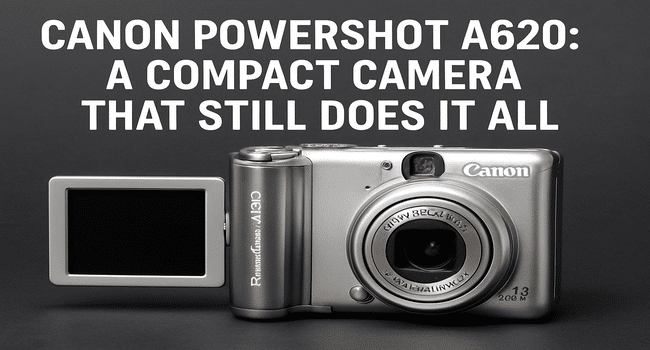Table of Contents
The Canon PowerShot A620 belongs to the PowerShot A line relatively large compact models with a somewhat bulky appearance. They use LR6/AA batteries, and Canon has kept the body large to make it easier to handle. While components inside have been shrinking, the hands of users are not.
Despite being compact, the A620 is quite comfortable to hold. Most men will need to press their fingers together, but the design ensures fingers rarely interfere with the flash. The control keys are well located, offering direct access to important functions and a dual menu system for everything else.
Display and Viewfinder
The A620 features a 2″ LCD display that bends and rotates in many directions. It allows you to shoot in a crowd or from difficult angles and folds into a compartment that protects it when not in use. The optical viewfinder is equipped with two LEDs to show proper conditions, although it’s not very accurate. Most users will rely on the LCD display, which gives a better idea of the frame.
Focusing and Lens Capabilities
Focusing is automatic at nine points (AiAF), with options for central area focusing and manual focus. Manual focusing includes zoom for the central area, making it practical and not just theoretical.
The lens covers 35 to 140mm (35mm equivalent), which is standard. It performs well at the minimum focal length and loses some aperture at the maximum. Macro photography is very good down to 1 cm at wide angle and 25 cm at full zoom.
Shooting Modes and Exposure Settings
Moving away from full auto mode gives access to P, S, A, and M modes. Several preset modes are also included, such as portrait, landscape, and underwater (with a waterproof case). Aperture can go down to f/8, shutter speeds range from 15 seconds to 1/2500 s covering all standard needs.
Three metering modes are available: center, area, and matrix. Area mode may cause errors, so beginners should use matrix or center mode.
ISO, White Balance, and Color Control
ISO can be set from 50 to 400. Higher ISO increases noise. White balance has all necessary presets plus manual adjustment. The “My Colors” function allows real-time color edits. The camera can also save the uncorrected version alongside the processed one.
Flash and Lighting Options
The built-in flash has a range of 3–4 meters and supports no flash, forced flash, slow sync, and shutter closing flash. Exposure compensation is available, but external flash sync is not. Canon offers a compatible accessory flash triggered by the built-in one.
Continuous Shooting and Video
Single and burst shooting are supported, with almost 2 frames per second. Shooting latency is low. The self-timer can be set for 2, 10, or up to 30 seconds. Multiple frame capture is also possible.
Video is recorded in AVI (Motion JPEG) with mono sound. Resolutions encompass 640×480, 320×240, and 160×120. Frame quotes are 30 or 15 fps, with 60 fps in 320×240 mode. Maximum record size is 1 GB, requiring a excessive-pace SD card.
Storage and Image Format
Files are saved only in JPEG, with three compression levels. With minimal compression, file sizes range from 3 to 4 MB with low artifacts. While some hobbyists may miss RAW format, JPEG is reasonable in this category.
Playback and Connectivity
Standard playback functions are available, including rotation and audio notes. Slideshows are limited to 3 seconds per frame. The A620 supports DPOF for printing.
It connects via USB 2.0 and includes a power socket and proprietary 3.5 mm AV output.
Power Supply and Battery Life
Canon chose standard AA batteries, not included in the box. NiMH rechargeables with a charger are recommended. Battery life is around 500 frames with the LCD as a viewfinder, depending on flash use and shooting habits. Power efficiency is excellent overall.
A Real User Problem and the Solution
After not using the camera for several years, a user reported confusion when trying to enable manual focus and couldn’t remember how to switch out of full auto mode. The LCD was rotating fine, but the menu wouldn’t allow certain settings. The original printed instructions were long gone.
By searching the Service manual online and landing on manuals.online, they were able to find the correct Canon PowerShot A620 instruction manual instantly with no login, no download, no paywall. The manual clearly explained that full manual options are only available when switching from the green auto mode. Once the mode dial was adjusted, the full functionality returned.
The Canon PowerShot A620 gives users almost everything they need: a high-quality LCD, full control over settings, excellent macro performance, and reliable build quality. For those who value practical design and real manual options in a compact format, it’s still a great tool and when you need help, the instruction manual is just a click away from a manuals site.
Read more on KulFiy
